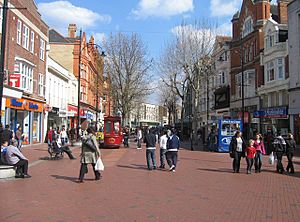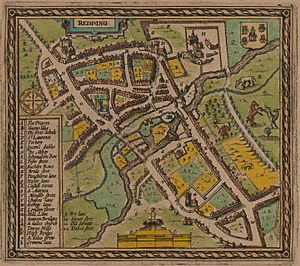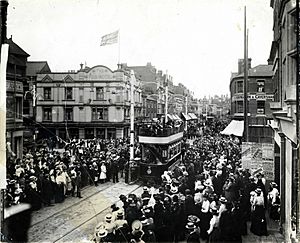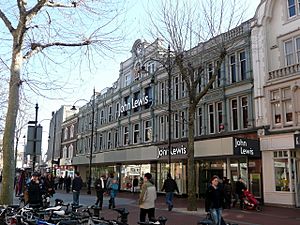Broad Street, Reading facts for kids

View east of Broad Street in 2008
|
|
| Length | 0.25 mi (0.40 km) |
|---|---|
| Location | Reading, Berkshire, England |
| Postal code | RG1 |
| Coordinates | 51°27′20.11″N 0°58′17.96″W / 51.4555861°N 0.9716556°W |
Broad Street is a busy street in Reading, England. It's mostly for people walking, and it's the main shopping street in the town centre. It stretches for about 0.25 miles (0.4 km) from west to east. At its western end, it meets Oxford Road, West Street, and St Mary's Butts. To the east, it turns into King Street after crossing Minster Street and Butter Market.
Today, Broad Street is famous for its shops. It has two big shopping centres, The Oracle and Broad Street Mall, at each end. But this street isn't just about shopping; it also played a part in English history, especially during the Battle of Reading (1688), sometimes called the Battle of Broad Street.
Contents
History of Broad Street
How Broad Street Began
The town of Reading started a very long time ago, during the Saxon period. It was first built around St Mary's Church, which is south of where Broad Street begins today. In 1121, Reading Abbey was built to the north of Broad Street's eastern end. This new abbey helped the town grow quickly.

Broad Street and Friar Street were created by the Abbey around this time. They were made to connect the newer part of town, built by the Normans, with the older Saxon area.
You can see how Reading looked long ago on a map made by John Speed in 1611. On this map, Broad Street was called Brode Stret. It started at St Mary's Butts (then called Old Street) and Oxford Road, then went east. Back then, it only had two side streets: Chain Street to the south and Cross Street to the north. The eastern part of Broad Street was different. It had two narrow streets, Fisher Row and Butcher Row, with buildings in between them.
Famous People and Events
William Laud, an important leader in the church, was born in 1573 on Broad Street. His house was where Queen Victoria Street is now. During the English Civil War, a famous house on the corner of Broad Street and Minster Street was used by a military leader named Robert Devereux. This house had even hosted Elizabeth I before!
Broad Street was also the main place for the second Battle of Reading in 1688. This battle, also known as the Battle of Broad Street, was the only big fight during the Glorious Revolution. In this battle, the army of King James II was defeated by troops supporting Prince William of Orange. Just two days after his army lost in Reading, King James left London and went to France. William became King of Britain in 1689.
Changes Over Time
In 1862, the buildings in the middle of what is now the eastern end of Broad Street were taken down. This joined Fisher Row and Butcher Row into one wider street, making it part of Broad Street. In 1879, the first horse-drawn tram line in Reading opened along Broad Street.
In 1903, Reading Corporation Tramways started using electric trams on Broad Street, replacing the horse-drawn ones. The next year, a big change happened when Queen Victoria Street was built. This new street cut through old buildings to connect Broad Street directly to Reading station, which had opened in 1840.
The last trams ran on Broad Street until 1939. After that, trolleybuses took over. These were then replaced by diesel buses in 1968. In 1970, Broad Street was closed to most traffic, allowing only buses and local access. Other cars were sent onto a new one-way system around the town.
In 1995, Broad Street became even more pedestrian-friendly. The buses that used to go down the street were rerouted. The street was then redesigned with red bricks, trees, sculptures, and places for street traders.
Shopping Fun
Broad Street is home to the large department store John Lewis & Partners, which used to be called Heelas. You can also find many other well-known shops here, like Boots, H&M, Marks and Spencer, Next, Sainsbury's, schuh, and W H Smith. The Waterstone's bookstore on Broad Street is special because it's in a beautifully converted old chapel from 1707.
The Oracle shopping centre has a direct entrance from Broad Street. Inside, you'll find many more big stores, including Debenhams and House of Fraser. It also has a wide choice of restaurants and bars.
Union Street, often called Smelly Alley by locals, is a narrow street that connects Broad Street to Friar Street. It got its nickname from the fishmonger's and greengrocer's shops that used to be there. While there are fewer food shops now, it still has many unique local stores.



